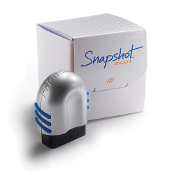
On Monday, insurance giant Progressive announced that, judging by the huge amount of data it has collected from policyholders using its Snapshot device, real information collected about a person’s driving behavior appears to be by far the best predictor of how much it will cost to insure him or her. And if the company is able to successfully defend its usage-based insurance patents, that may mean it’s in a position to see its customer base dramatically improve in both quantity and quality.
The company’s Snapshot program is a discount program in which enrollees plug a data-collection device into their vehicles and let Progressive track their driving behavior—like instances of hard braking and rapid acceleration, the number of miles put in behind the wheel, etc.—in order to determine whether they exhibit safe driving tendencies and deserve a discount. According to the insurer, about 70 percent of drivers who try Snapshot end up being eligible for a discount, although they didn’t say the size of the average discount. It can go up to 30 percent.
Progressive says in its new analysis that before driving behavior was factored into the equation, looking at the number of driving-record points that a person had was the No. 1 way to predict how much the insurer would have to pay out in claims for that particular driver. But actual driving data, the company now says, “is more than twice as powerful” as points in forecasting a person’s claims activity.
And these conclusions aren’t being drawn from a small data set. Progressive first introduced usage-based programs to policyholders in just three states in 2004, but it is now available in 42 states and the District of Columbia, which has left the company has about 5 billion miles’ worth of data culled from about 1 million policies to back up its rating structure.
Progressive made another big announcement on Monday aimed at getting Americans to try out its data collection program: regardless of who their current insurer is, drivers in every state with access to Snapshot can now take a 30-day test run with the device to see how much they could potentially save by switching to Progressive’s usage-based system.
That’s a pretty shrewd move on Progressive’s part. The company says it already has about 8.88 million active personal auto insurance policies as of May 2012, with an 8 percent share of the total personal car insurance market. And that share could grow if drivers insured with other top insurance companies realize they could be getting better rates from Progressive.
The long-term implications of this paint a very rosy picture for Progressive’s future. If safe drivers take Snapshot for a spin and find out that they could be getting significant savings based on their good behavior behind the wheel, they might jump ship to join Flo and her team. That means more customers for Progressive and fewer customers for the other guys.
But it wouldn’t simply mean more drivers joining Progressive. It would mean more good drivers joining Progressive, since the customers most likely to make the switch after giving Snapshot a test drive would be the ones who displayed the best driving habits and therefore got the best savings. So that could mean Progressive having a growing customer base of good drivers who file fewer claims, which means more of the premiums collected by the insurer stay with the insurer. Meanwhile, the people who test out Snapshot and find that their behaviors aren’t good enough to warrant a discount stay with the other guys, meaning the percentage of policyholders who are not so hot grows at those companies, and they have to devote more of the money they collect in premiums to paying and processing claims.
This scenario, though, is dependent on Progressive having and maintaining exclusive access to usage-based rating structures. Snapshot won’t necessarily ensure success for Progressive if all the other guys get their own Snapshot-like auto insurance discount programs with similar effectiveness and adoption rates.
But aside from the fact that Progressive Insurance already has a couple years’ worth of a head start on the other major insurers, it also has a handful of patents related to usage-based pricing models. A 2008 paper on pay-as-you-drive insurance from the Brookings Institution said Progressive has four major patents that could prohibit, or at least impede, other insurers’ adoption of usage-based pricing. According to the report’s authors, at least three of the four patents “involve a ‘monitoring system for determining and communicating the cost of insurance.’” For example, they quote the following section from one of the company’s patents: “A process for acquiring and recording vehicle insurance related data during a time period via an on-board computer and recording system for adjusting an insurance cost.”
The Brookings Institution said there may be some weaknesses to Progressive’s patents, however, and that other insurance providers may ultimately end up being able to use the technology. But it could be a hard-fought battle, they say, and we could see that battle playing out sooner rather than later. In May, Progressive submitted a complaint to a U.S. district court saying that it is “suffering from the effects” of patent infringement, and mentions State Farm’s Drive Safe & Save program and The Hartford’s TrueLane program directly in the complaint. How that complaint is handled could have serious implications down the road.